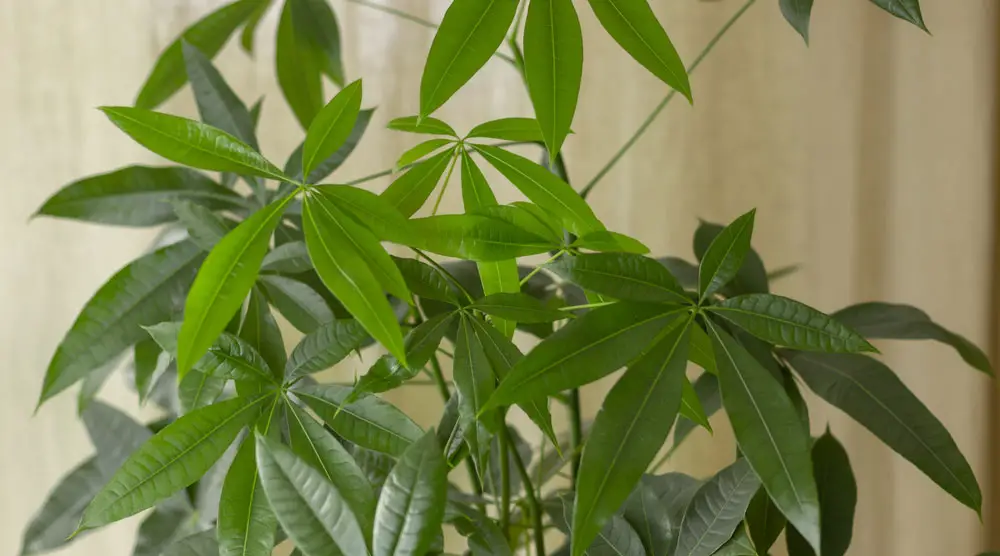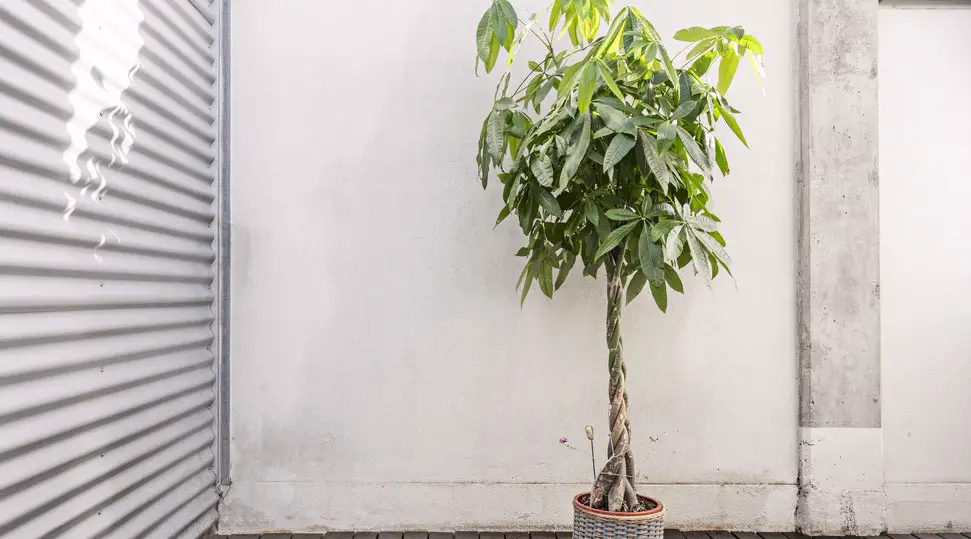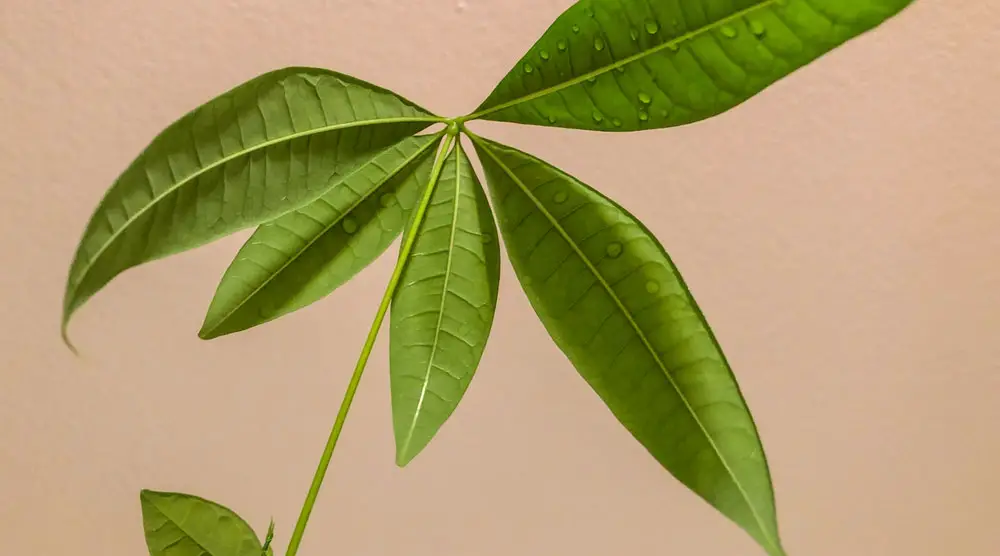How to Prune a Money Tree For Bigger Growth – Follow These 8 Easy Steps:

This post follows our research editorial guidelines.

When is a tree not a tree? When it’s a carefully trimmed money tree (Pachira aquatica), of course! These popular good-luck tokens are often sold as sweetly braided bonsai, decorated in prosperous reds and golds. They won’t stay small for long if left to their own devices, and without regular pruning they’ll soon sprout up to heights that may beggar belief. How do you stop your luck from shooting up further than your reach?
To keep a money tree at a manageable size, it should be trimmed each spring. Regular pruning will also keep it in good health, promote growth, and allow you to effectively treat disease and pest damage. Always use clean sharp tools, and consider propagating cuttings to produce additional money trees.

Table of Contents
What is Pruning and Why is it Important to Trim a Money Tree?
Pruning is the practice where you cut away parts of a money tree to encourage new growth, remove damaged leaves and branches, or correct problems with poor care. It’ll also prevent a large plant becoming unwieldy or taking over your living space.
This last part is particularly salient when it comes to money trees. In the wild these lovely trees reach upwards of 60 feet tall. Without regular trimming, a dainty bonsai can quickly become a mass of bare trunk with just a tuft of foliage at the top. They don’t call it a tree for nothing
How to Tell When Trimming is Needed
Through the year it’ll be necessary to cut away damaged, sick or otherwise sub par bits of your money tree. Keep an eye out for:
- Damaged branches or leaves
- Diseased leaves
- Yellowing leaves
You can also trim purely to improve the appearance of your money tree or to keep it at a height you enjoy. You don’t really need an excuse if you’d like one that’s smaller, bushier, or a particular shape.
It’s best to do this sort of pruning in the earlier part of the spring. This is the start of the growing season, and it’ll give your money tree the best chance at recovery.
Pruning for Height
The first and most important reason to trim a money tree is to keep it small. Without regular pruning, your desktop money tree will do its best to hit its maximum height of 60 feet. They don’t mess around, and will wind up scraping the ceiling if left unpruned.
Pruning for Growth Stimulation
Sharon Globig, an advisor at the United States Department of Agriculture shared some helpful advice to fellow gardeners on this topic:
“Prune off any dead, damaged, or dying leaves/stems to keep the plant healthy. Judiciously pruning the leaves will stimulate new growth if you cut in front of a leaf node.”
United States Department of Agriculture Ask Extension service
I’d also suggest you cut off any leggy, overly long branches, and lop away trunks that have over-extended themselves. Don’t fret if your poor money tree seems bare for a while – it won’t take long for these enduring favorites to make a recovery.
Pruning for a Bonsai Effect
Money trees are a popular choice for bonsai. Their slender, pliant trunks lead well to the sculptural approach of bonsai masters, thriving even when braided or wired into shape.
To prune for a bonsai effect, it’s wise to approach it as much an art as it is a gardening technique. Consider what you want from the shape of the plant, and how you want to balance the shape of the pot with that of the money tree itself. Cut away any leaves or stems that don’t fit into your vision. Trim back for height, too – all your careful sculpting will come to naught if your tree shoots up and sheds its lower leaves.
Trimming Yellow Leaves
Yellow leaves are often a sign of problems with cultivation. Before you chop check for other problems, and I write extensively on how to diagnose and treat yellowing money trees here[1] .
The short version is to check for problems with watering, light levels and things like pests and disease. Once you’ve worked out why the leaves are yellow it’s safe to chop them.
If there’s only one or two leaves in the group with issues I’d suggest removing them individually, but if most of them are yellow just trim back the whole stalk. The exception is leaves yellowed by pests or disease. You don’t want either of those to spread, so remove the entire group.
How to Trim a Money Tree
Pruning a money tree can often be an intimidating prospect to less experienced gardeners. It can feel almost like an amputation! In practice, however, it’s more like a haircut – a chance to freshen up and get a crisp new look!

How to Pick the Best Tools for Trimming a Money Tree
Size is the biggest consideration when choosing the tools best suited for trimming a money tree. Small tools are best for small trees, and larger ones for large trees.
I like a good sharp pair of garden shears for all my indoor pruning. They’re great all rounders, a solid option for both smaller and larger indoor plants. A comfortable grip is important too.
For smaller specimens a sharp sturdy pair of kitchen scissors may do the job. It’s best to reserve such scissors exclusively for use in the garden.
For sizable money trees a pruning saw is a good tool to have to hand. A good quality sharp pruning saw will make short work of thicker material, and produce cuts that heal faster and more efficiently.
Technique to Trim a Money Tree:
You will need:
- Clean garden shears or scissors. A pruning saw may be needed for larger plants.
- Rubbing alcohol
- A clean cloth
- Gardening gloves
- Water
- Good quality liquid fertilizer
- Cinnamon powder (optional)
Step One: Prepare Your Tools
Lay out your tools ahead of time, and make sure they are sharp and clean. I like to wipe or spray my tools with a bit of rubbing alcohol in order to keep my cuts free of infection. Money trees ooze sap when trimmed, so keep a cloth dampened with a bit more alcohol handy to wipe tools from time to time. A sticky pair of shears are unsafe to use, for both yourself and your plant, so keep them clear as you work.
Step Two: Examine Your Money Tree
Take a moment to work out exactly what it is you want from the pruning. Are you prompting growth? Trying to keep it in check? Or is this treatment for disease? Think about what shape you’d like at the end, too – do you want a tall and reaching plant, or a more elegant bonsai effect?
Examine outlying branches and make a note of which ones you want to remove, and do likewise for damaged leaves or ones that are yellowing or browned.
Keep an eye out for points of growth, or nodes. On a money tree, these nodes resemble crescent shaped bumps, sometimes a paler color than the rest of the trunk. You’ll need them to guide your cuts.
Step Three: Work Your Way in
Pop on some garden gloves and get ready to cut! Start with the outermost branches and work your way in. Remember the nodes? Cut no more than about a half of an inch above them when trimming. The branches holding leaf groups can be cut away at a similar distance from the main trunk.
If you’re aiming to reduce height, you can also just up and saw the top half of the money tree. Astonishingly, this won’t kill the plant at all, especially if there’s plenty of growth further down the plant. The money tree will simply start regrowing its truck from the node closest to the cut. Larger cuts should be made at a 45° angle to the trunk or branch. This helps prompt the money tree to regrow a new shoot at the site.
Step Four: Check Your Progress
Take a moment to step back and assess your progress. Once a cut is made it can’t be undone, so take your time and don’t make any hasty decisions. You can always come back and continue in a day or two if you change your mind.
If you’re happy with your choices, you can move on to the next step. Failing that, pick up your tools once more and keep at it until you’re pleased with the result.
Step Five: Prevent Infection
Once you’re done cutting, I’d suggest treating any larger cuts with powdered cinnamon. It’s a very effective antibacterial and antifungal agent, ideal at preventing infection. All those cuts are open wounds, after all. Dust the exposed tissue liberally and you’re good to go.
Step Six: Water Heavily
Give your money tree a deep watering, preferably with a quarter strength dose of liquid fertilizer added for good measure. Lost sap is lost water, and a good drink will replenish your money tree’s reserves. The extra fertilizer will help fuel new foliage and assist in healing, too.
Step Seven: Clean Your Tools
Clean your tools with alcohol and put them away once dry.
Step Eight: Propagate New Plants or Decompose
Now for the fun part – what to do with the off-cuts?
Dead and unwanted leaves can be composted. Sick or insect damaged trimmings should be disposed of in household garbage to prevent the spread of disease or infestation.
But the rest? It’s a golden opportunity, as money tree cuttings propagate readily in both water and soil.
Single stalks will quickly developing roots if placed in a vessel of water and left in a well lit room. If you’ve lopped off a portion of trunk, the entire thing can be dropped into a larger container and kept well lit. It won’t take long to grow good cluster of roots. Once they’re around three to six inches long you can just plant it in an appropriate potting blend.
Alternately you can dip the ends of the cuttings in rooting hormone and tuck them firmly into a seed starting mix. I’ve tried this a few times with a variety of plants and can testify to the need for using a seed starting mix. Anything that is rich in fungal spoors (even beneficial ones) or the bacteria found in compost will hinder the plants ability to develop a root system. Once they have an inch or so of root you can move them to a more permanent pot with better soil.
A seasonal prune can result in more money plants. Luck and prosperity, in abundance!

Frequently Asked Questions
Can I cut the main stem of a money tree?
Cutting back the main stem of the money plant is a solid treatment for a taller specimen that’s headed for the heavens. Avoid portions of the trunk that have been braided, but anything else is fair game.
You can also opt to stimulate the nodes by “scraping” with a sharp knife, removing just enough bark back to show the green tissue underneath. About 95% of the time the scraped nodes will produce a new shoot.
How far back can you cut a money tree?
Money trees are resilient and fast growing, and will spring back from quite enthusiastic pruning. I’d suggest no more than half the height of the plant if cutting back an overly large money tree, or no more than two thirds of the foliage for a more sculptural trim.
Can you cut the top of a money tree off?
Absolutely! Removing just the newest, youngest shoots at the crown of the tree is often called “pinching” and is an excellent way to keep the height of this tropical wonder in check.
You can also take off more substantial portions of the main trunk. If you take a look at many commercially available money trees, you’ll often see a very clear difference in the thickness of the braided trunks and the part of the plant that has foliage. This is because at some point the growers have lopped off the top in order to keep it small and easy to ship.
Final thoughts
I’m always inspired by the resilience and versatility of the money tree plant. They’ll thrive just as well as a foot high bonsai as they do a massive 60 foot tree. No matter how hard we cut them down to size, they always spring back – This resilience must have been how they got their name!
